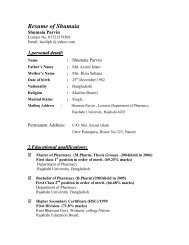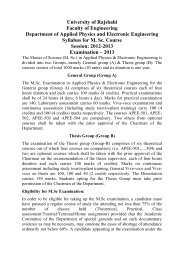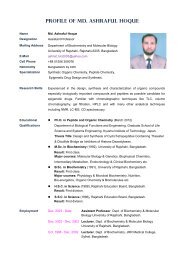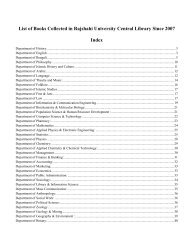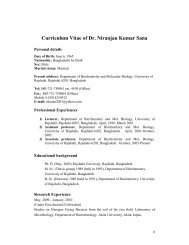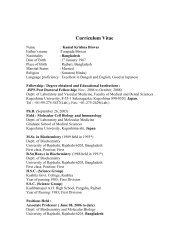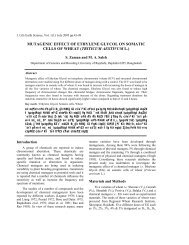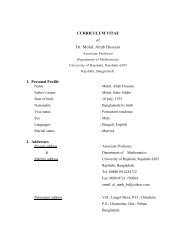University of Rajshahi
University of Rajshahi
University of Rajshahi
Create successful ePaper yourself
Turn your PDF publications into a flip-book with our unique Google optimized e-Paper software.
<strong>University</strong> <strong>of</strong> <strong>Rajshahi</strong><br />
Syllabus for Postgraduate<br />
Program (2009-2010)<br />
IES Office<br />
4 th Science Building<br />
<strong>University</strong> <strong>of</strong> <strong>Rajshahi</strong>, <strong>Rajshahi</strong> 6205<br />
Telephone: +880 721 750930<br />
+880 721 750041 Ext 4166<br />
Fax :+880 721 750064<br />
Email: ies_ru_2004@lycos.com<br />
Website: www.iesru.edu.20m.com<br />
The <strong>University</strong> reserves the right to revise information, requirements, regulations, etc. at any time. Whenever changes occur,<br />
an effort will be made to notify those concerned.
POSTGRADUATE CURRICULA<br />
Postgraduate study in the Institute <strong>of</strong> Environmental science, <strong>University</strong> <strong>of</strong> <strong>Rajshahi</strong> will lead to M.Phil<br />
and PhD degrees. To obtain IES postgraduate degrees, in addition to completion <strong>of</strong> necessary coursework,<br />
students must prepare and successfully defend a thesis, which will investigate a problem that initiates,<br />
expands, strengthens or clarifies existing knowledge in the field. Students will be required to define an<br />
appropriate problem for investigation, review relevant information, develop a study plan incorporating<br />
techniques appropriate for the problem, implement the plan, and relate the results to already existing theory<br />
or a body <strong>of</strong> knowledge in the field. For a Doctor <strong>of</strong> Philosophy degree, however, students must make<br />
original contribution to their field <strong>of</strong> research.<br />
A recognized Masters degree (i.e., 3-year Bachelor plus 1-year Masters) or equivalent degree in any<br />
discipline related to environment is the normal entry requirement for the program. However, student from<br />
social science and business discipline background shall have a science background in higher<br />
secondary certificate level. Performances in the degree and/or relevant experience will also be considered<br />
in granting admission.<br />
Students seeking admission to postgraduate degree program are required to file their completed<br />
application forms which must include previous academic transcript, records <strong>of</strong> pr<strong>of</strong>essional qualifications if<br />
any, and a synopsis <strong>of</strong> their proposed research plan. Application forms for admission to the institute can be<br />
obtained directly from the IES Office.<br />
Successful applicants are normally registered for M.Phil in the first instance and those who wish to study<br />
for the Ph.D are transferred at a later stage (normally after one year) subject to satisfactory progress.<br />
Each student will be allotted a supervisor who has enough knowledge on the<br />
proposed research work to provide frequent personal supervision <strong>of</strong> the progress <strong>of</strong><br />
research and if necessary, co-supervisor(s) abiding by the principles <strong>of</strong> the<br />
<strong>University</strong> may be allotted.<br />
The academic programs at the Institute will be designed for people from a wide range <strong>of</strong> disciplinary<br />
backgrounds, pr<strong>of</strong>essional experience and environmental knowledge. It is envisaged that as well as<br />
environment, such backgrounds and experience may include physical science, life science, social science,<br />
economics, law, management and engineering, landscape architecture and the health pr<strong>of</strong>essions. The<br />
Institute aims at providing a flexible program, which can be tailored to individual student’s needs.<br />
The IES program will rest on a solid foundation <strong>of</strong> Core and Optional Courses, which will provide,<br />
respectively, both a basis <strong>of</strong> critical appreciation <strong>of</strong> frameworks <strong>of</strong> Environmental Science and basic<br />
‘environmental literacy’ in key disciplinary areas. Since students will bring very different knowledge bases<br />
to the program and may need to fill knowledge gaps, the latter courses will be seen as a key attribute in the<br />
environmental field, which necessarily involves collaborative as well as integrated decision-making by<br />
specialists from many disciplines. For this to be effective mutual understanding <strong>of</strong> others’ disciplinary<br />
perspectives is critical. Compulsory Courses will also provide for appreciation <strong>of</strong> the inherently inter-and<br />
trans-disciplinary nature <strong>of</strong> environmental science. Beyond this foundation, students, with the assistance <strong>of</strong><br />
the supervisors, will be free to design a balance program to suit their specific needs. This program will be<br />
taken from a wide range <strong>of</strong> Optional Courses, which will enhance their specialist expertise and will expand<br />
their knowledge and skills in the particular field related to their thesis research works.<br />
Students enrolled in the IES Postgraduate Program are required to complete a coursework made<br />
up <strong>of</strong>:<br />
<br />
Eight (8) Compulsory Courses <strong>of</strong> 24 credits<br />
Four (4) Optional Courses <strong>of</strong> 8 credits<br />
Course curricula and course description <strong>of</strong> Compulsory and Optional Courses for the IES Postgraduate<br />
Program follows:<br />
Page 2 <strong>of</strong> 12
Postgraduate Course Curricula (2009-2010)<br />
Compulsory Courses<br />
Number<br />
Title<br />
Total Hours <strong>of</strong><br />
Marks Lecture<br />
Credit<br />
ENV C701 Introduction to Environmental Science 75 42 3<br />
ENV C702 Ecology and Environment 75 42 3<br />
ENV C703 Environmental Pollution and Control 75 42 3<br />
ENV C704 Environmental Impact Assessment (EIA) 75 42 3<br />
ENV C705 Geo-Environment 75 42 3<br />
ENV C706 Research Methodology 75 42 3<br />
ENV C707 Disaster and Environmental Management 75 42 3<br />
ENV C708 Geo-informatics and Resource Mapping 75 42 3<br />
Total 8 (Eight) courses 600 336 24<br />
Number<br />
Four Optional Courses (200 marks 112hs. and 8 credits)<br />
Total<br />
Title<br />
Marks<br />
Hours <strong>of</strong><br />
Lecture<br />
ENV O751 Environmental Chemistry 50 28 2<br />
ENV O752 Environmental microbiology and Ecotoxicology 50 28 2<br />
ENV O753 Biodiversity 50 28 2<br />
ENV O754 Waste Management 50 28 2<br />
ENV O755 Water Resources: Planning and Management 50 28 2<br />
ENV O756 Climate Change and Global Warming 50 28 2<br />
ENV O757 Energy and Environment 50 28 2<br />
ENV O758 Environmental Health and Sanitation 50 28 2<br />
ENV O759 Wetland and Land degradation Management 50 28 2<br />
ENV O760 Environmental Policy and Modeling Design 50 28 2<br />
ENV O761<br />
Environmental Planning, Population and<br />
Sustainable Development<br />
50 28 2<br />
ENV O762 Environmental Law, Regulation and Human Rights 50 28 2<br />
ENV O763 Society and Environment 50 28 2<br />
ENV O764 Environmental Psychology 50 28 2<br />
Credit<br />
Page 3 <strong>of</strong> 12
POSTGRADUATE COURSE DESCRIPTIONS<br />
COMPULSORY COURSES<br />
ENV C701 Introduction to Environmental Science<br />
Definition, history <strong>of</strong> development <strong>of</strong> environmental science, field and their scope, significance,<br />
components <strong>of</strong> environment and their interactions; the general environment: radiation, heat, light, gravity,<br />
pressure, sound, physicochemal and phases, the atmospheric gases, dissolved salts as limiting factors,<br />
ecological relations <strong>of</strong> soil, abiotic and biotic factors in relation to individual; different kind <strong>of</strong><br />
environment, evolution <strong>of</strong> environment, ecological principle and their application, human influences on<br />
ecosystem, environmental ethics, religion and environment, interrelated nature <strong>of</strong> environmental problems,<br />
human impacts on natural environment, major environmental problems and issues.<br />
ENV C702 Ecology and Environment<br />
Ecology: autecology <strong>of</strong> species, population ecology, community ecology and ecosystem ecology; climatic,<br />
physiographic, edaphic and biotic factors. Productivity, food chain, food webs, trophic levels and<br />
ecological pyramids. Principles and concepts pertaining to biogeochemical cycles<br />
Habitat, ecological niche, ecological equivalents, sympatry and allopatry, natural selection, artificial<br />
selection. Fresh water, marine, estuarine, coastal, terrestrial and desert ecology.<br />
Limiting and regulating factors: Concept, Liebig’s Law, ecotypes, conditions, biological magnifications <strong>of</strong><br />
toxic substances, anthropogenic stress.<br />
Environmental monitoring: bio-monitoring, bio-indicator, stress, response, risk, sensitive indicators,<br />
cumulative indicators and eco-toxicology.<br />
ENV C703 Environmental Pollution and Control<br />
Water Pollution: classification <strong>of</strong> water pollutants, sources and consequences <strong>of</strong> water pollution and<br />
wastewater treatment techniques.<br />
Air pollution: sources and types <strong>of</strong> air pollutants, air quality standard, criteria and air pollution control.<br />
Noise sources. Noise pollution and abatement measures.<br />
Major soil contaminants and solid wastes – domestic waste, domestic solid waste, disposal <strong>of</strong> municipal<br />
and industrial waste; sludge treatment and disposal facilities; recovery <strong>of</strong> resources.<br />
Hazardous waste- Identification and characteristics <strong>of</strong> hazardous waste; processing and treatment <strong>of</strong><br />
hazardous waste. Radiation sources in the environment. Biological effects <strong>of</strong> radiation, dose limits.<br />
Technical controls for radioactive sources and radiation apparatus.<br />
Basic concept <strong>of</strong> chemical analysis: mole concept, analytical methods & techniques.<br />
ENV C704 Environmental Impact Assessment (EIA) and Environmental Management.<br />
Nexus between development and environment. Origin and development <strong>of</strong> EIA in USA and Bangladesh.<br />
Role <strong>of</strong> USEPA in developing the EIA in developing countries. Relation <strong>of</strong> EIA to sustainable<br />
development. EIA costing. EIA in project planning and implementation.<br />
Screening, Initial Environmental Examination (IEE) and detailed EIA. Categorization <strong>of</strong> projects and major<br />
criteria for project site location. EIA methodology: baseline information collection, scooping, impact<br />
assessment methods (checklist and matrix), mitigative measures, environmental management plan (EMP)<br />
and environmental monitoring. Application procedure for environmental clearance.<br />
Role <strong>of</strong> GIS in EIA baseline study. Risk assessment and risk management. Mitigation measures: Green<br />
bills. Review <strong>of</strong> EIA procedures in some developing countries: India, Srilanka, Thailand, Malaysia and<br />
Philippines.<br />
Page 4 <strong>of</strong> 12
ENV 705: Geo-Environment<br />
Geology and Environment, Importance <strong>of</strong> Geology in environmental science; Solar system; History <strong>of</strong><br />
Earth and Geological Time scale.<br />
Major Earth components:<br />
Atmosphere: Structure and composition <strong>of</strong> atmosphere; Significance <strong>of</strong> physical environment as a life<br />
support system; Incoming and outgoing radiation; Green house effect and Global warming.<br />
Lithosphere: Internal structure <strong>of</strong> the earth, composition <strong>of</strong> crust, mantle and core; Rock; Soil, soil<br />
classification, soil pr<strong>of</strong>ile and soil composition.<br />
Hydrosphere: World wide distribution <strong>of</strong> water, Surface water and ground Water, Vertical distribution <strong>of</strong><br />
groundwater, Hydrologic cycle, composition <strong>of</strong> ground Water, Principal chemical constituents in<br />
groundwater-Their sources, concentration and effect on usability; Aquifer and aquifer types; Sea water,<br />
composition <strong>of</strong> sea water, Sources <strong>of</strong> sea salt and salinity; Sea water intrusion and its Environmental Impact<br />
in coastal area <strong>of</strong> Bangladesh.<br />
Biosphere: Definition; Extent <strong>of</strong> biosphere etc.<br />
Geo- environment <strong>of</strong> Bangladesh: Area, population, physiography , hydrology, climate and vegetation;<br />
Geological characteristics <strong>of</strong> Bangladesh; Introduction to the Geo-environment <strong>of</strong> Indian subcontinent –<br />
physiographic division , mountains, glaciers and River basins-Ganges, Brahmaputra, Meghna and Indus.<br />
Biogenic deposits: Origin <strong>of</strong> petroleum; Natural gas, crude oil and coal,-their composition and<br />
classification ; Petroleum formation and reserve in Bangladesh; Impact <strong>of</strong> mining development on<br />
environment.<br />
Natural hazards: Floods, Soil erosion, Earthquakes, Volcanoes, cyclone and tornadoes, tidal surge,<br />
Tsunamis, Landslides – hazard characterization, extent <strong>of</strong> damage, prediction, control and management.<br />
ENV C706 Research Methodology<br />
Introduction to research; major components <strong>of</strong> research; field surveys; preparation <strong>of</strong> questionnaire;<br />
acquisition <strong>of</strong> data; sorting and handling primary and secondary data; statistical analysis <strong>of</strong> data;<br />
population; sampling methods; probability distribution: binomial, Poisson’s and normal distributions;<br />
statistical estimation; hypotheses; type I and type II errors; significance level; analysis <strong>of</strong> variance and<br />
covariance; parametric and non-parametric tests: z, t and F tests; chi-square, correlation test etc. regression<br />
analysis; multivariate analysis; ANOVA, ARMA analysis etc.<br />
Basic skills: basic computing, finding information, safety, ethics and other fundamental matters; project<br />
development: provides training and guidance in planning and managing research work; personal skills:<br />
skills in negotiations, team working, assertiveness and other transferable skills; proposal writing and<br />
research thesis writing; scientific article writing; journalistic essay writing etc.<br />
Data processing: Mathematical modeling s<strong>of</strong>tware and programm based studies on the environmental<br />
problems. Micros<strong>of</strong>t Excel, Graphical representation, Data Entry, Spreadsheet Analysis.<br />
Page 5 <strong>of</strong> 12
OPTIONAL COURSES<br />
(Any Four)<br />
ENV O751 Environmental Chemistry<br />
Chemistry <strong>of</strong> transition metals- definition, properties and their compounds. Chemistry <strong>of</strong> non-metals,<br />
definition, properties, and their compounds. Concept and scope <strong>of</strong> environmental chemistry; chemistry <strong>of</strong><br />
atmosphere, hydrosphere, biosphere and lithosphere; pollutants, contaminants and toxic substances in the<br />
environment and their fates; techniques to detect pollution in the environment; identification <strong>of</strong> sources <strong>of</strong><br />
pollution;<br />
Analytical techniques, Lambert Law, Beer Law, Optical method <strong>of</strong> analysis. Atomic absorption<br />
spectrophotometer. Electrical method, potentiometer. High Performance Liquid Chromatography (HPLC),<br />
Gas Chromatography (GC) Ion Chromatography (IC), etc.; statistical treatment <strong>of</strong> analytical measurement<br />
data; accuracy, reproducibility, significant value, inter-lab measurements, intra-lab measurements etc.<br />
ENV O752 Environmental Microbiology and Ecotoxicology<br />
Microbiology<br />
Introduction – definition, scope, classification <strong>of</strong> environmental microbes, the rhizosphere. R:S ratios,<br />
mycorhizae, root nodules, microbial plant, animal and human diseases with reference to sanitation:<br />
microbes and man – nature at functions <strong>of</strong> beneficial and pathogenic microbes: Environment and microbes<br />
– distribution pattern, types, composition, succession, productivity etc <strong>of</strong> microbial population in air, water<br />
and soil.<br />
Biogeochemical role <strong>of</strong> microorganisms – biogeochemical transformation <strong>of</strong> nitrogen, carbon, sulfur, and<br />
other nutrients, biodegradation <strong>of</strong> pollutants: Microbes in food – microorganisms in food, spoilage <strong>of</strong> food,<br />
microbial examination <strong>of</strong> food, control <strong>of</strong> microbes: Microbes in domestic and waste water – indicator<br />
organisms, coliform bacteria, bacteriological techniques in waste water treatment process.<br />
Microbial decomposition <strong>of</strong> chemically complex materials; use <strong>of</strong> bacteria and fungi to detoxify wastes,<br />
and conversion into usable substances. Prevention <strong>of</strong> biodeterioration <strong>of</strong> valuable materials, biodegradation<br />
<strong>of</strong> minerals, metals, cellulosics, aromatics, hydrocarbons, and wastewater treatment.<br />
Ecotoxicology<br />
Classification and sources <strong>of</strong> toxic substances. Pathways <strong>of</strong> toxic substances into ecosystem – principles<br />
and methods <strong>of</strong> studying toxins in an ecosystem. Effect <strong>of</strong> toxic substances – pesticides and therapeutic<br />
agents. Mutagenesis – distribution, biochemistry and abuse: Bioaccumulation, biomagnification and<br />
biomonitoring <strong>of</strong> toxic substances. Toxicological case studies in developed and under developed counties.<br />
Biochemical degradation <strong>of</strong> pollutants inside the cell: Cellular interaction with the pollutants: Pollutant<br />
interaction with biological system at different levels e.g., organisms, organs and tissues, cells. Active vs<br />
inactive processes: Enzymatic degradation by monoxygenesis: Role <strong>of</strong> cytochrome P450 and its multiple<br />
form: Metal toxicity; chemical form, metal biomacromolecule interaction, teratogenecity and<br />
carcinogenecity: Cellular/Tissue injury; altered membrane permeability, free radical formation, lipid<br />
peroxidation, lysosomal degradation, superoxide dismutase.<br />
ENV O753 Biodiversity<br />
Biodiversity: Concept, definition and different levels <strong>of</strong> biodiversity. biological, economical and social<br />
need for biodiversity, Species diversity and ecosystem stability. Biodiversity with respect to niche structure<br />
and tropic level. Assessment <strong>of</strong> biodiversity status and determination <strong>of</strong> IUCN threat categories. Sources <strong>of</strong><br />
genetic variation and biodiversity functions. Economical and social importance <strong>of</strong> biodiversity.<br />
Economical and social importance <strong>of</strong> biodiversity. Extinct, endangered, rare and vulnerable species.<br />
Biodiversity conservation methods: in-situ and ex-situ, gene bank, biotechnology, national park, zoo and<br />
herbarium. Eco-tourism and its benefit.<br />
Page 6 <strong>of</strong> 12
Different approaches <strong>of</strong> biodiversity conservation and management, registering biodiversity. Valuing<br />
biodiversity resources and their contribution to agriculture, community health and environment. Causes <strong>of</strong><br />
biodiversity loss. Techniques <strong>of</strong> species reintroduction and restoration <strong>of</strong> the degraded habitat.<br />
Biodiversity policy and legislation. Biodiversity and intellectual property right: Wildlife conservation and<br />
management: Status <strong>of</strong> biodiversity conservation in Bangladesh: Agenda 21 (Convention on biodiversity).<br />
ENV O754 Waste Management<br />
Solid waste - Sources and types <strong>of</strong> solid waste; physical and chemical properties <strong>of</strong> solid waste – domestic<br />
waste, domestic solid waste, disposal <strong>of</strong> municipal and industrial waste – different methods; sludge<br />
treatment and disposal facilities; recovery <strong>of</strong> resources.<br />
Hazardous waste- Identification and characteristics <strong>of</strong> hazardous waste; processing and treatment <strong>of</strong><br />
hazardous waste – physical processes, chemical processes, thermal processes biological processes; natural<br />
systems for hazardous waste treatment – waste stabilization pond, aquatic weeds and constructed wetland<br />
system; hazardous waste disposal, biological detoxification and application <strong>of</strong> biotechnology, institutional<br />
and legal framework.<br />
ENV O755 Water Resources: Planning and Management<br />
Environmental problems associated with groundwater in aquifer systems <strong>of</strong> importance to Bangladesh.<br />
Environments will include natural saline groundwater, deep sedimentary basins, groundwater-surface water<br />
interaction, fractured took, alluvial plain, and unconsolidated sediments.<br />
Principles <strong>of</strong> water quality control. Monitoring and sampling methods. Groundwater contamination<br />
evaluation. Site management and investigation. Risk assessment and risk management. Aquifer protection<br />
and rehabilitation. Remediation. Case studies.<br />
Basic concepts in the water resource planning and management: Precipitation, evaporation, transpiration,<br />
infiltration: Water resource development, and conservation in dry periods and in arid regions. Wetlands and<br />
water resources: soil-water relationship: Human impacts on water resources: Irrigation and flood control<br />
system. Participation <strong>of</strong> beneficiaries, formation <strong>of</strong> user’s group. Case studies <strong>of</strong> Farakka Barrage, the<br />
Flood Action Plan and the National Water Management Plan <strong>of</strong> Bangladesh.<br />
ENV O756 Climate Change and Global Warming<br />
Overview <strong>of</strong> climate system. Climate variation during the postglacial period and to assess prospects for<br />
future decades and, second, <strong>of</strong> current understanding <strong>of</strong> key climate issues such as the working <strong>of</strong> the<br />
climate system, impacts on humanity, the natural causes <strong>of</strong> climate change and anthropogenic effects on<br />
climate.<br />
Basic Science - Covers the fundamental science underlying the problem <strong>of</strong> global climate change induced<br />
by greenhouse and gas emissions, including greenhouse gas sources, gas cycles, modeling effects on global<br />
temperature, sea level and regional climate, detection <strong>of</strong> the global warming signal and climate impacts.<br />
Policy Responses - Adaptation and emission control, the two possible societal responses to the threat <strong>of</strong><br />
global climate change, and it involves the study <strong>of</strong> the practical application <strong>of</strong> policy-orientated models<br />
dealing with, for example, the imposition <strong>of</strong> emission targets, energy taxes and land management options as<br />
well as study <strong>of</strong> the Framework Convention on Climate Change.<br />
ENV O757 Energy and Environment<br />
Introduction – history and scope; importance: Energy use; world energy use, reserves. Energy demand and<br />
energy supply – approaches to energy balance, production and consumption <strong>of</strong> energy, transformation <strong>of</strong><br />
primary energy to secondary energy, final energy: Energy scenario in Bangladesh.<br />
Measurement <strong>of</strong> energy conservation – industrial, commercial, residential and transport sector; Thermal<br />
power plants energy conservation measures and pollution control hydroelectric power plants, potential<br />
impact on biodiversity and habitat loss: Nuclear power plant – disposal <strong>of</strong> radioactive waste.<br />
Renewable energy technologies: Solar energy, introduction to semiconductor p-n junction diodes,<br />
photoelectric effect, solar cell modules, application <strong>of</strong> solar cells, solar cells in rural electrification and<br />
other areas. Geothermal, wave, tidal and ocean energy importance <strong>of</strong> renewable energy in Bangladesh.<br />
Page 7 <strong>of</strong> 12
Biomass: introduction, biomass conservation, generation, biogas digester and design, operational problems<br />
and kinetic consideration <strong>of</strong> biogas digesters, introduction to pyrolysis and gasification. Wind energy; basic<br />
theory, types <strong>of</strong> turbines and their application. Clean Development Mechanism (CDM).<br />
ENV O758 Environmental Health and Sanitation<br />
Environment and diseases. Transmission <strong>of</strong> disease. Classification <strong>of</strong> transmission mechanisms (waterborne,<br />
water-washed, water based and insect vector). Classification <strong>of</strong> infections (excreta-related: faecaloral<br />
by bacteria and non-bacteria, soil transmitted helminthes, beef and pork tapeworms, water-based<br />
helminthes, excreta related insect vectors). Vectors, parasites and their control. Principles <strong>of</strong> toxicology.<br />
Epidemiological studies. Development <strong>of</strong> health criteria. Application to home, work and community<br />
environment. Comprehensive planning. Health administration.<br />
Environmental factors and quality <strong>of</strong> human health. Types <strong>of</strong> toxic substances affecting human health.<br />
Adverse effects <strong>of</strong> air pollution, water pollution and land degradation. Village, urban, industrial and<br />
institutional sanitation.<br />
Introduction to hygienic sanitation system. Water pollutants removal and purification techniques, water<br />
supply and different types sanitary toilets and waste management. Environmentally sound settlement<br />
planning.<br />
ENV O759 Wetland and Land Degradation Management<br />
Different types wetlands <strong>of</strong> Bangladesh and its area. Social, economical and biological importance <strong>of</strong><br />
wetlands. Causes for loss <strong>of</strong> wetlands. Conservation activities <strong>of</strong> wetlands through govt-NGO and local<br />
people’s participation.<br />
Physiographic and limnological characters <strong>of</strong> all types <strong>of</strong> wetlands. River, canal, ditch and lake water,<br />
nutrient cycles, eutrophicaion and its control, plankton and benthos <strong>of</strong> limnologic significance, distribution<br />
and role <strong>of</strong> aquatic plants in inland water. Wetland pollution and remedies in Bangladesh perspective.<br />
Major causes <strong>of</strong> land degradation in Bangladesh and in the world. Increased salinity and desertification<br />
problems.<br />
Inter-relationships <strong>of</strong> scientific, technical, cultural and social issues facing agriculture. Maintenance <strong>of</strong> soil<br />
fertility and techniques to control soil erosion. Principles <strong>of</strong> land use and environmental considerations.<br />
Agriculture and land use policy analysis. Case studies <strong>of</strong> the green revolution in developing nations<br />
together with their merits and demerits.<br />
ENV O760 Geographic Information System (GIS) and Remote Sensing<br />
Introduction - elements and principles. Data acquisition, storage, manipulation and interpretation.<br />
Importance <strong>of</strong> GIS in planning, management, monitoring and evaluation. Applications <strong>of</strong> GIS in resource<br />
management, monitoring, forecasting changes, service planning, transport network management, public<br />
protection and security services, mineral resource exploration and evaluation, watershed management,<br />
conservation and river basin planning. Hardware requirements. Use and application <strong>of</strong> GIS s<strong>of</strong>tware:<br />
ArcInfo, ArcView, ERDAS, IDRISI and ILWIS.<br />
Introduction - systems, techniques and commercial services. Primary data acquisition. Photogrammetry and<br />
remote sensing – advances in airborne and spaceborne sensor systems, digital photogrammetry, image<br />
understanding and computer-vision leading to integrated acquisition techniques. Concepts, systems and<br />
methods <strong>of</strong> image transformation and information extraction from primary data. Quality and performance<br />
<strong>of</strong> both topographic and thematic data processing. Interpretation and analysis <strong>of</strong> images. Optimization <strong>of</strong><br />
geoinformatics processes – planning and management <strong>of</strong> integrated geoinformation production systems.<br />
ENV O761 Environmental Planning, Population and Sustainable Development<br />
Significance <strong>of</strong> environmental planning and design in sustainable development. Planning processes and<br />
methodologies – content and function, the plan as a process, social and historical considerations, elements<br />
<strong>of</strong> planning and team work. Concept <strong>of</strong> planning in the developed and developing countries. Protection and<br />
restoration <strong>of</strong> natural system. Design plan – implementation process, comprehensive plan, zoning plan,<br />
industrial performance, history preservation, flexible zoning, specific plan.<br />
Page 8 <strong>of</strong> 12
Concepts <strong>of</strong> sustainable development, dynamic relationship <strong>of</strong> population, environment and sustainable<br />
development; methods <strong>of</strong> integrating population variables into development planning and institutional<br />
framework for formulating population and development planning.<br />
Ecological and other perspectives on the interrelationship <strong>of</strong> population and environment; consequences <strong>of</strong><br />
environment degradation; carrying capacity; utilization <strong>of</strong> resources; population-resource ratio; population<br />
and land utilization; population growth and increasing pressure on food and other resources; factors<br />
affecting supply and demand <strong>of</strong> natural resources, and environmental impact <strong>of</strong> development programs.<br />
ENV O762 Environmental Law, Regulation and Policy<br />
Basic concepts <strong>of</strong> policy, regulation and law; how a law is made, judicial systems; different types <strong>of</strong> law;<br />
history and relevance <strong>of</strong> environmental law; legal aspects <strong>of</strong> environmental resource management; origin <strong>of</strong><br />
environmental law in Bangladesh and other countries: major environmental laws, policies and regulations<br />
such as Environment Conservation Act (ECA, 1995), Environment Conservation Rules (ECR, 1997),<br />
Green Court (2000), Forest Ac (2000), Wildlife Preservation Act, Fish Ac etc. and some case studies;<br />
Roles <strong>of</strong> law enforcing authorities; contradictions in existing laws/policies <strong>of</strong> Bangladesh; strengths and<br />
weakness <strong>of</strong> different laws; ethics <strong>of</strong> resource management: obligation to future generation; the Lane<br />
Ethics: responsibilities <strong>of</strong> developed and developing nations;<br />
Environmental dispute and resolution over common resource sharing: river water sharing (Ganga, Nile,<br />
Indus, etc), trans-boundary air pollution, biological diversity & intellectual etc.; international<br />
environmental conventions, protocols and treaties and their implementation in Bangladesh; international<br />
organizations involved in environmental law, protocols, conventions and treaties (UNEP, UNDP, Green<br />
Peace, CBD, WWF, CITES, IUCN, etc<br />
Bangladesh Environment Policy, 1992. The Environmental Action Plan 1992. National agriculture policy,<br />
1999. Outline <strong>of</strong> the environmental issues <strong>of</strong> the agriculture sector. Bangladesh Fifth Year Plan (FFYP) in<br />
order to promote, nature, protect and expand nature and natural resources.<br />
ENV O763 Society and Environment<br />
Concept, nature and functions <strong>of</strong> society; social structure and social processes; social Institutions; approach<br />
to study social phenomena: Positivism and Humanism Different schools <strong>of</strong> thoughts and perspectives used<br />
in analysis and understanding social phenomena in social science; culture and social life; community life in<br />
rural and urban settings; influence <strong>of</strong> geographical heredity, Social and techniques factors and development<br />
on social life; interactions in human life: the Ecological Systems theory: The micro system, the more<br />
systems, the Exo system and the Macrosystem; the ecosystems model: Environmental –structural –culture –<br />
Family-etc.; intervention strategies with the people : Intervention with individuals, groups and<br />
communities- practicing social work for motivating and ensuing peoples participation in environmental<br />
issues and programs.<br />
Revisiting the concepts <strong>of</strong> Communication, Media, Environment and Awareness. Functions <strong>of</strong><br />
communication, and communication media. Importance <strong>of</strong> communication media in meeting environmental<br />
problems. Media theories and its critiques. Environmental psychology and the role <strong>of</strong> mass media in raising<br />
human awareness about environment. Researches on the role <strong>of</strong> communication media in raising people’s<br />
awareness and relevant learning.<br />
Environmental politics and International media. The role <strong>of</strong> the print, electronic, and folk media in<br />
Bangladesh to overcome environmental enigma and evaluation <strong>of</strong> the concerned media policies and related<br />
studies. Investigating the body <strong>of</strong> environment related indigenous knowledge in Bangladesh and the harms<br />
caused by mass media particularly in the sector <strong>of</strong> agriculture. Planning for communication campaign and<br />
advocacy for creating mass awareness for environment.<br />
Fundamentals <strong>of</strong> interrelation between environment policy-management issues and politico-administrative<br />
settings, socio-politico dynamics in the developing nations with special reference to Bangladesh.<br />
Environmental issues in the perception and papers <strong>of</strong> different stakeholders <strong>of</strong> the governance. Peoples<br />
participation in governance <strong>of</strong> environmental issues-experience <strong>of</strong> northern and southern countries. Go-<br />
NGO partnership in environmental management. Gender environment and governance.<br />
Page 9 <strong>of</strong> 12
ENV O764 Environmental Psychology<br />
The Environment: Current Events influencing environment, Methods used in environment psychology,<br />
environmental perception, cognition, attitudes.<br />
Effects <strong>of</strong> Environmental stresors: Environmental stress, temperature, humidity, sunshine, wind, Ion<br />
concentration, chemical pollution, noise, pollution density, urbanization, crowding, territoriality, privacy,<br />
personal space.<br />
Application <strong>of</strong> Environmental Psychology: Institutional design, residential design, environmental<br />
disaster, and technological catastrophe.<br />
Page 10 <strong>of</strong> 12
Recommended Reference:<br />
Anderson, R.M., Turnerand, R.D. and Taylor, L.R. 1994. Population Dynamics. Blackwell Pub.<br />
Arms, K. 1990. Environmental Science, London Sundars College Pub.,<br />
Ave`yj gv‡jK f~uBqv, 2003. cwi‡ek `~lY I wbqš¿Y, cÖ_g LÛ: evqy `~lY Ges wØZxq LÛ: cvwb<br />
`~lY| cÖKvkK, wg‡mm wbjydv †eMg, wm - 24, wmwWG, Avi/G G¨wiqv, c~e© bvwmivev`,<br />
†cvó e· bs: 4209, PUªMÖvg|<br />
Bala, B.K. 1997. Energy and Environment-Modeling and Simulation. NOVA Sci. Pub.<br />
Boaden, P.J.S. and Seed, R. 1985. An Introduction to Coastal Ecology. Blackie.<br />
Bouwer, H. Ground Water Hydrology.<br />
Brammer, H. 1996. The Geography <strong>of</strong> the soils <strong>of</strong> Bangladesh, <strong>University</strong> Press Ltd.<br />
Bridgan, H. 1990. Global Air Pollution. John Wiley and Sons.<br />
Browlow, H. Geochemistry.<br />
Burrus, L. and Spiegel, H. J. Earth in Crisis, 2 nd Edition.<br />
Byrne, K. Environmental Science, 2 nd Edition.<br />
Carlson, B: Psychology the Science <strong>of</strong> Behaviour; Allyn and Bacon.<br />
Chapman, J.L. and Reiss, M.J. 1997. Ecology: Principles and Application. Cambridge Univ. Press.<br />
Chhatwall G.R. 1993. Environmental Water Pollution and Control. Anmol. Pub., New Delhi.<br />
Chiras, D. Daniel. 1985. Environmental Science. A framework for Decision making. The Benjamin/Cummings Publishing Company,<br />
Inc California.<br />
Corson, W.H. The Global Ecology Handbook, Boston, Beacon Press.<br />
Cowon, J. Environmental Design.<br />
Dhaliwal, G.S. 2000. Fundamentals <strong>of</strong> Environmental Science, Kalyani Pub.,<br />
Elliot, R. 1995. Environmental Ethics. OUP.<br />
Emiliani, C. Planet Earth.<br />
Enger, E.D. and Smith B.F. 1995. Environmental Science: a study <strong>of</strong> interrelationship. WM C. Brown Pub.<br />
Fresland, P. 1997. Habitats and the Environment. Hodder and Stoughton. London.<br />
Gain, P. 2002. Bangladesh Environment-Facing the 21 st Century, SEHD, Bangladesh.<br />
Gaston, K.J. 1996. Biodiversity- a biology <strong>of</strong> numbers and difference, Blackwell Science.<br />
Gaston, K.J. and Spicer, J.I. 1998. Biodiversity an Introduction. Blackwell Science.<br />
Hannigan, J.A. 1995. Environmental Sociology. Routledge, London.<br />
Horne, A. Goldman, C. 1994. Limnology, GcGGraw Hill Inc.<br />
Horton, P.B. and Hant C.L. Sociology (5 th Edition), Mc-Graw Hill.<br />
Howard, D. and Remson, I. Geology in Environmental Planning.<br />
Howksworth, D.L. 1995. Biodiversity-Measurement and Estimation. Chapman and Hall.<br />
Jackson, A.K.W. and Jackson, J.M. 1996. Environmental Science, Longman.<br />
Keller, E.A. Environmental Geology, 4 th Edition.<br />
Khan, F.H. 1991. Geology <strong>of</strong> Bangladesh. Wiley Eastern, New Delhi.<br />
Krausk, K.B. and Bird, D.K. Introduction to Geochemistry.<br />
Krebs, C.J. 1994. Ecology. Benjamin Cumming.<br />
Krebs, C.J. 1995. Ecological Methods. Benjamin Cummings.<br />
Krishnan, M.S. 1982. Geology <strong>of</strong> India and Burma. CBS Pub. and and Distributors, India.<br />
Kudesia, V.P. Water Pollution, Meeraut, Pragati Prokashon.<br />
Leboyer, C.L. Psychology and Environment.<br />
Lehninger, A.L. Nelson, D.L. and Cox, M.M. 1993. Principles <strong>of</strong> Biochemistry. CBS Pub. and Distributors<br />
Manaham, E. Stanley. 1993. Fundamentals <strong>of</strong> Environmental Chemistry, LEWIS Publishers. New York.<br />
Page 11 <strong>of</strong> 12
Mishra S.R. 1996. Assessment <strong>of</strong> Water Pollution. APH Pub., New Delhi.<br />
Mishra, S.J. and Mani, D. 1994. Agriculture Pollution. Ashis Pub., New Delhi.<br />
Mukherjee, B. 1996. Environmental Biology, Tata McGraw-Hill Publishing Company Limited.<br />
Nath, B., Hens, L., Compton, P. and Devuyst. D. 1999. Environmental Management in Practice, Volume – 2, Routledge Butler and<br />
Tanner Limited London.<br />
Odum, E.P. 1996. Fundamental <strong>of</strong> Ecology, Nataraj Pub., Dehra Dun, India.<br />
Pickering, K.T. and Owen, L.A. 1997. An Introduction to Global Environmental Issues. Routledges.<br />
Rao, M.N. 1989. Air Pollution, Tata McGraw HillPub., Co., LTD.<br />
Richardson, DHS 1987. Biological Indicators <strong>of</strong> Pollution. Royal Iris Academy.<br />
Rose, J. 1998. Environmental Toxicology. Gordon and Beach.<br />
Russell, V. and Arrkkelin: Environmental Psychology, Prentice Hall, Englawood Cliffs, New Jersey.<br />
Sattar, S.A. Introduction to Environmental Laws <strong>of</strong> Bangladesh.<br />
Scott and Foresman. Earth Science.<br />
Sharma, P.D. 1995. Environmental Biology and Toxicology, Ann. Ar. bor. Sci. Pub.<br />
Sharma, P.D. 2000. Environmental Biology and Toxicology, MacMillan, India.<br />
Shukla, R.S. and Chandel, P.S. 2002. Plant Ecology and Soil Science. S. Chad and Company Limited, New Delhi.<br />
Sparks, D.L. 1995. Environmental Soil Chemistry. Academic Press.<br />
Tank, R. Focus as Environmental Geology.<br />
Thornbury W.D. 1969. Principal <strong>of</strong> Geomorphology. New Age Intern’s Ltd., India.<br />
Todd, D.K. 1989. Groundwater Hydrology. John Wiley and Sons.<br />
Tripathi, A.K. 1990. Water Pollution. Ashish Pub., New Delhi.<br />
Trivedi, R.N. 1997. A Text book <strong>of</strong> Environmental Science. Anmol Pub.,<br />
UNEP 1997. Handbook <strong>of</strong> Environmental Law. UNEP, Kenya.<br />
Warren, L.M. and Gibson, J. 1999. Environment Law and Policy. Blackwell Science.<br />
Wentz, C.A. 1989. Hazardous Waste Management. McGraw-Hill Book Co.,<br />
Wetzel, R.G. 1997. Limnology. WB Sounders.<br />
Whyte, R.O. 1980. Crop Production and Environment. Faber and Faber Ltd. London.<br />
Wild, L. 1996. Soils and the Environment. Cambridge Univ. Press.<br />
Wright, J. 2003. Environmental Chemistry, London.<br />
Page 12 <strong>of</strong> 12




